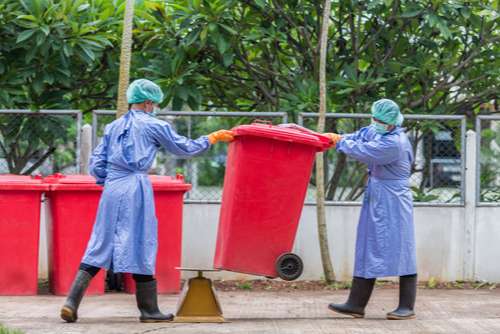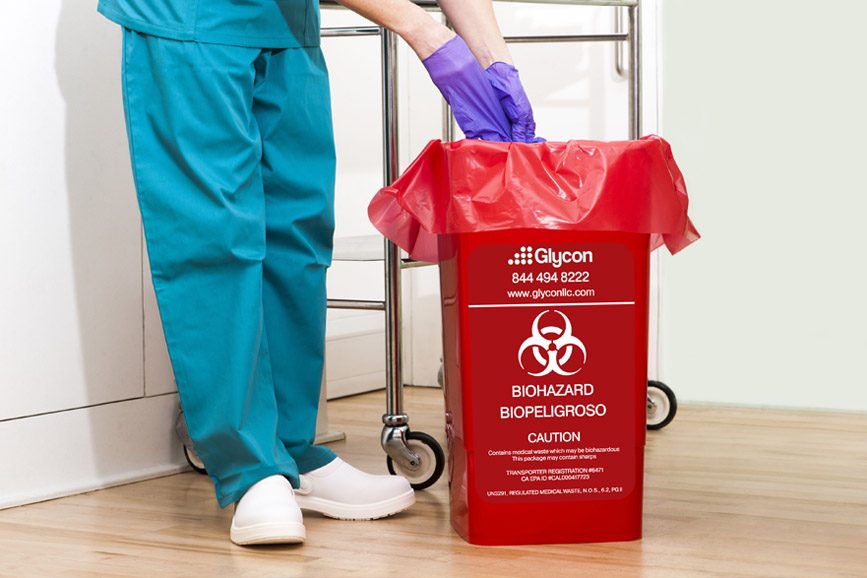Medical Waste Removal Mastery: Where Service Quality Fulfills Wellness Requirements
Medical Waste Removal Mastery: Where Service Quality Fulfills Wellness Requirements
Blog Article
Effective and Ecologically Friendly Medical Garbage Disposal Solutions
In the ever-evolving field of medical care, the problem of clinical garbage disposal remains a topic of critical importance. As healthcare facilities, centers, and other healthcare centers aim to give top quality patient treatment, they must additionally deal with the difficulty of successfully and sensibly dealing with their waste - medical waste removal services. In an age where ecological sustainability goes to the leading edge of public awareness, discovering solutions that are both ecologically pleasant and effective is not only an issue of compliance yet likewise a testimony to the dedication of health care organizations in the direction of a greener future. From waste segregation techniques to ingenious recycling efforts, this conversation will check out the various strategies utilized to tackle this pushing concern, leaving you fascinated and eager to check out the prospective solutions that exist ahead.
Waste Partition Practices
Effective waste partition methods are vital to make sure the correct and safe disposal of clinical waste. Clinical waste, that includes products infected with possibly transmittable materials, should be managed in such a way that reduces the risk of damage to both public health and wellness and the environment. Proper waste segregation plays an essential role in accomplishing this goal.
Waste partition entails the splitting up of different kinds of waste based upon their features and possible dangers. This procedure ensures that each kind of waste is dealt with and dealt with suitably (medical waste disposal services with WasteX). It starts at the point of generation, where healthcare centers should have marked bins and containers for different waste classifications, such as sharps, infectious waste, pharmaceutical waste, and non-hazardous waste
By setting apart clinical waste at the source, doctor can stop cross-contamination and lower the risk of direct exposure to infectious representatives. This method also assists in the recycling and recuperation of particular products. Segregating and reusing clean plastics and glass minimizes the demand for raw materials and reduces the ecological effect of clinical waste disposal.

Autoclaving and Sanitation Methods
In order to make sure the risk-free and appropriate disposal of clinical waste following reliable waste segregation practices, medical care centers must utilize autoclaving and sanitation methods. Autoclaving is a commonly utilized technique that uses high-pressure steam to sanitize clinical waste.
This entails dealing with the waste with chemicals such as ethylene oxide or hydrogen peroxide, which eliminate bacteria by disrupting their cellular structure. It is essential to note that chemical sanitation needs proper handling and disposal of the chemicals used, as they can be hazardous to human health and the setting if not taken care of appropriately.
On-Site Waste Treatment Systems
Healthcare centers have actually executed on-site waste therapy systems to resolve the disposal of medical waste in a efficient and risk-free manner. These systems offer a economical and hassle-free solution for managing clinical waste produced within the center. On-site waste treatment systems use various modern technologies to treat and dispose of clinical waste on-site, reducing the requirement for transport to off-site facilities.
One frequently used on-site waste treatment system is the microwave innovation. This modern technology makes use of microwave energy to decontaminate and sanitize medical waste, decreasing its volume and rendering it secure for disposal. An additional system is the chemical sanitation technology, which entails dealing with medical waste with chemicals to eliminate pathogens and minimize its unsafe nature. This method is particularly efficient for liquid clinical waste.
On-site waste therapy systems supply several advantages. Firstly, they get rid of the risk of clinical waste being mishandled during transport, reducing the possibility for contamination and exposure to unsafe materials. Additionally, these systems assist medical care centers conform with waste administration regulations by providing a reliable and hassle-free disposal method. Furthermore, on-site treatment systems minimize the total environmental impact medical waste disposal services with WasteX of medical waste by lessening transportation and the requirement for land fill space.
Recycling and Repurposing Initiatives
As medical care facilities strive for sustainable waste monitoring practices, they are progressively exploring recycling and repurposing initiatives as a way of reducing the environmental influence of clinical waste. Recycling and repurposing campaigns entail discovering ingenious methods to reuse or transform clinical waste into new items or products. This not just helps to reduce the quantity of waste that winds up in landfills or burners but additionally lowers the consumption of basic materials and energy needed for producing new items.
One example of recycling in the healthcare market is the reprocessing of single-use medical gadgets. These gadgets, such as surgical instruments or catheters, are typically thrown out after a single use. However, improvements in modern technology and rigid sanitation procedures have made it possible to securely clean, decontaminate, and recycle these devices multiple times. This not only minimizes the quantity of waste generated however also conserves healthcare centers considerable prices connected with acquiring new tools.
Another recycling campaign includes the recycling of plastic containers, such as medicine containers or syringe coverings. These containers can be gathered, arranged, and sent out to recycling centers where they are refined, thawed down, and changed right into brand-new plastic products. This aids to preserve sources and decrease the demand for virgin plastic manufacturing.
Along with reusing, repurposing campaigns entail locating alternative usages for clinical waste. Shredded paper waste from medical documents or product packaging materials can be repurposed as bed linen product for animals or as insulation material. Natural waste such as food scraps from health care facilities can be composted and utilized as plant food in yards or farming areas.

Renewable Energy Solutions
One efficient method to reducing the environmental influence of health care procedures includes executing eco-friendly power solutions. Medical care facilities, such as facilities and hospitals, take in considerable amounts of energy for various objectives, consisting of illumination, home heating, air conditioning, and operating medical equipment. By transitioning to renewable resource sources, these facilities can significantly reduce their carbon impact and contribute to a more sustainable future.

Implementing renewable resource solutions in medical care centers not just lowers greenhouse gas emissions however also offers long-term cost savings. While the preliminary financial investment in renewable resource infrastructure may be higher, the long-term functional costs of renewable resource systems are significantly lower contrasted to conventional fossil fuel-based energy sources. In addition, renewable energy systems are dependable and can provide a uninterrupted and steady power supply, making certain continuous healthcare services also throughout power failures or emergencies.
Conclusion
To conclude, implementing efficient and eco-friendly clinical waste disposal solutions is important for maintaining a sustainable health care system. By taking on waste partition methods, autoclaving and sterilization methods, on-site waste treatment systems, reusing and repurposing campaigns, and renewable energy read the full info here solutions, healthcare centers can substantially lower their environmental effect. These steps not only secure the setting but also advertise public health and wellness and safety and security. As a result, it is essential for medical care companies to focus on the application of these lasting waste disposal methods.
It starts at the point of generation, where medical care facilities here should have designated bins and containers for various waste classifications, such as sharps, contagious waste, pharmaceutical waste, and non-hazardous waste.
In order to make sure the appropriate and secure disposal of medical waste complying with efficient waste segregation techniques, medical care facilities need to utilize autoclaving and sanitation techniques.Healthcare facilities have actually implemented on-site waste therapy systems to deal with the disposal of clinical waste in a secure and efficient manner. On-site waste treatment systems make use of various technologies to deal with and get rid of of clinical waste on-site, minimizing the demand for transport to off-site centers.
As medical care centers strive for lasting waste monitoring techniques, they are increasingly discovering recycling and repurposing campaigns as a method of minimizing the environmental impact of clinical waste. - medical waste removal service
Report this page